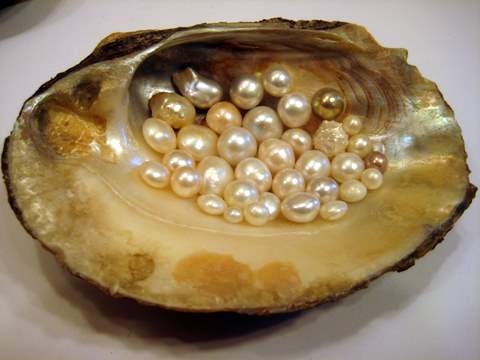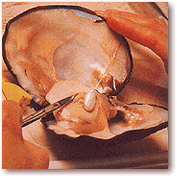|
Fresh Water Pearls in the USANative Americans of the Atlantic Coastal areas and the Mississippi River Basin were the first to collect and use U.S. fresh water pearls and shells. Pearl pendants and ear pendants were worn by both sexes and both pearl and shell were used for decorative purposes on articles of clothing. Some of the tribes used pearls as tributes, reportedly Powhattan (Pocahontas' father) had large stores of pearls received as tribute. Additionally, armlets, pendants, and gaming pieces were made from mussel shell.  Natural USA Freshwater Pearls Photo by Kari Natural fresh water pearls are seldom perfectly round or even nearly round, more often than not they are baroque, slugs, or wings. Many pearls, both natural and cultured, have beautiful color and luster. Fresh water pearls are noted for their wide range of color, they can be found in white, silvery white, pink, salmon, red, copper, bronze, brown, lavender, purple, green, blue, cream, and yellow. Although white is the most common color, the most desirable are the pastel pinks, roses, lavenders, and purples. The different colors are a function of the mussel species, genetics, water quality, and the position of the pearl in the shell. Generally, pearls assume the color of the shell in which they form. Problems can arise in putting together matched strands because of the wide range of pastel colors. The shape of the nucleus and its position in the mussel determines the shape of the cultured pearl. The shapes recovered include rounds, pears, eggs, drops, buttons, domme, and baroques. In turn, the baroques include many recognized shapes such as, nuggets, dog teeth, wings, hammers, twins, barrels round-a-circle, and rosebuds. The baroques are becoming popular for use in the manufacture of rings, earrings, and pendants. Cultured pearls come in all of the same colors as natural pearls. Freshwater shell and pearl mussels are from the family Unionidae, from which about 20 different species are commercially harvested. The common names of the most prolific species include the ebony, washboard, heel-splitter, pimple back, elephant ear, maple-leaf, three-ridge pig-toe, pistol grip, and butterfly. Peak commercial fishing is from April through September, when hundreds of independent divers operate in the rivers, streams, and lakes of the Eastern, Southern, and Central United States. A very profitable fishery supported a large shell button industry until World War II when plastic buttons displaced shell buttons. The fishery fell into disorganization and was dormant until the early 1950's. The mother of pearl industry and bead nucleus for the Japanese culture pearl industry have supported the fishery since the 1950's. During the 1990's, the value of U.S. mussel shell exports to Japan started at more than $50 million annually but has declined to about $35 million annually. Prior to 1992, fresh water pearls were primarily a byproduct of the shell industry. This changed with the coming of freshwater cultured pearl farms in Tennessee and California, and the increasing popularity of fresh water pearl jewelry with the U.S. consumers. The first experimental U.S. freshwater cultured pearl farm was established in Tennessee by John Latendresse in 1963. Latendresse is the father of U.S. cultured freshwater pearls, having spent nearly 30 years and more time, money, and effort than anyone else in the research and development of the industry. Since proving the technology for culturing freshwater pearls in the late 1970's, Mr. Latendresse has established five freshwater pearl farms. James Peach, who once worked with Latendresse, has established a single farm. Additionally, a single farm has been established in California using mussels from the Southeastern United States. These farms are the foundation of the U.S. freshwater cultured pearl industry, and the cultured pearl is the heart and future of the U.S. pearl industry. The ultimate size of the cultured pearl industry depends on a number of factors. The acreage of pollution free water available that is suitable for farms could decide the size of the industry. Yet, even before the limitation of available suitable water comes into play, two main factors, demand for cultured freshwater pearls and the supply, or the ability of the producers to meet this demand with acceptable goods routinely, will decide the future of the industry. Some individuals have already likened these two factors to the chicken and egg question; does the demand for the pearls come first, or does the adequate supply of acceptable goods come first. Indications are that both factors are currently complementing each other, and they are contributing to the healthy growth of the young industry. Demand for U.S. fresh water pearls is a function of quality. Quality is determined by the size, color, shape, degree of translucency, texture, ability to match and blend, and luster. Usually, the quality of U.S. fresh water pearls is as good or better than any other pearl. The possible exceptions are the availability of round pearls and the ability to match colors. Yet, it is thought by some that these exceptions are not detrimental, but that the variety of shapes and colors available are advantageous and are positive selling points. To date, 31 different States have reported production of freshwater pearls and shell. During 1993, 18 States reported production, they were Alabama, Arkansas, Georgia, Illinois, Indiana, Iowa, Kentucky, Louisiana, Minnesota, Missouri, Nebraska, North Dakota, Oklahoma, South Carolina, South Dakota, Tennessee, Texas, and Wisconsin. The bulk of the shell and pearl production came from Tennessee, Arkansas, Alabama, and Louisiana.  Cultured Fresh Water Pearl from Tennessee (Photo is courtesy of American Pearl Co.) The pearls are green, blue-green, yellow, or pink in color and may have high luster, but the texture is always coarser than that of other pearls. Some of the pearls are very large, as large as 60 carats. To date, all of the abalone pearls have been natural, but a move is underway to culture pearls in the farms where abalone are raised for their meat. Many of the abalone farmers are afraid of losing animals because of the culturing and have not entered the program. Possibly, in the near future an abalone cultured pearl industry may become a reality. It also appears that attempts are underway to start a saltwater cultured pearl industry in Hawaii. The Hawaiian industry would be based upon saltwater oysters. Only time will tell of the success or failure of the abalone and Hawaiian cultured pearl programs. It appears that the U.S. freshwater shell and pearl industries are well and growing. The pearls are beautiful, valuable, and the consumer is willing to purchase and wear them. The oldest of U.S. gemstones is doing well and its future is bright. Thank you to the USA government for this informative article on fresh water pearls. More on USA freshwater mussels. View and purchase USA freshwater pearls. |






